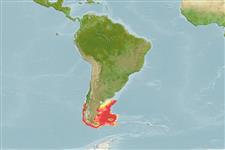Environment: milieu / climate zone / depth range / distribution range
Écologie
marin démersal; océanodrome (Ref. 51243); profondeur 30 - 1000 m. Subtropical; 40°S - 57°S, 76°W - 55°W (Ref. 1371)
Southeast Pacific and Southwest Atlantic: Patagonian region of Chile and Argentina, including the Falkland Islands and the Strait of Magellan.
Taille / Poids / Âge
Maturity: Lm ? range ? - ? cm
Max length : 50.0 cm TL mâle / non sexé; (Ref. 1371)
Épines dorsales (Total): 0; Rayons mous dorsaux (Total): 59-70; Épines anales 0; Rayons mous anaux: 54 - 63; Vertèbres: 52 - 54. A small variably shaped patch of teeth on head of vomer. Pectoral fin extending beyond anal fin origin. Ventral light organ present. Color uniformly brown; fins dark-edged (Ref. 1371). Caudal fin rounded (Ref. 27363).
Highest catches at 235 m. Females attain larger sizes than males. Larger individuals of both sexes move into deeper water. Utilized mainly for fishmeal; can be fried, microwaved and baked (Ref. 9988).
Life cycle and mating behavior
Maturité | Reproduction | Frai | Œufs | Fécondité | Larves
Cohen, D.M., T. Inada, T. Iwamoto and N. Scialabba, 1990. FAO species catalogue. Vol. 10. Gadiform fishes of the world (Order Gadiformes). An annotated and illustrated catalogue of cods, hakes, grenadiers and other gadiform fishes known to date. FAO Fish. Synop. 125(10). Rome: FAO. 442 p. (Ref. 1371)
Statut dans la liste rouge de l'IUCN (Ref. 130435)
Menace pour l'homme
Harmless
Utilisations par l'homme
Pêcheries: intérêt commercial mineur
Outils
Articles particuliers
Télécharger en XML
Sources Internet
Estimates based on models
Preferred temperature (Ref.
123201): 3.3 - 7.7, mean 5.7 °C (based on 115 cells).
Phylogenetic diversity index (Ref.
82804): PD
50 = 1.0000 [Uniqueness, from 0.5 = low to 2.0 = high].
Bayesian length-weight: a=0.00468 (0.00277 - 0.00790), b=3.11 (2.96 - 3.26), in cm total length, based on LWR estimates for this species & (Sub)family-body (Ref.
93245).
Niveau trophique (Ref.
69278): 4.4 ±0.3 se; based on diet studies.
Résilience (Ref.
120179): Milieu, temps minimum de doublement de population : 1,4 à 4,4 années (Assuming tm=2-3).
Prior r = 0.57, 95% CL = 0.37 - 0.85, Based on 1 stock assessment.
Fishing Vulnerability (Ref.
59153): Moderate vulnerability (40 of 100).
Climate Vulnerability (Ref.
125649): Moderate to high vulnerability (54 of 100).
Nutrients (Ref.
124155): Calcium = 58 [29, 126] mg/100g; Iron = 0.945 [0.508, 1.791] mg/100g; Protein = 17.6 [15.2, 19.6] %; Omega3 = 0.26 [0.13, 0.50] g/100g; Selenium = 44.8 [20.4, 95.5] μg/100g; VitaminA = 23.2 [6.5, 84.7] μg/100g; Zinc = 0.592 [0.395, 0.902] mg/100g (wet weight); based on
nutrient studies.
